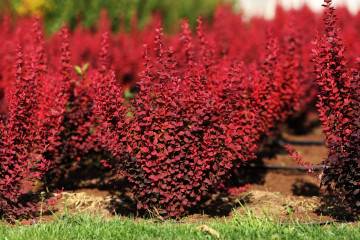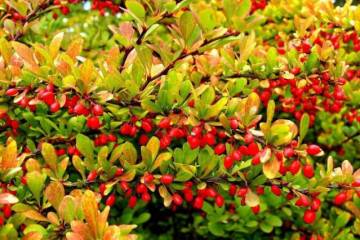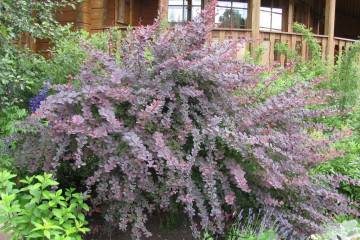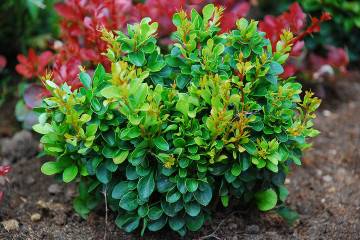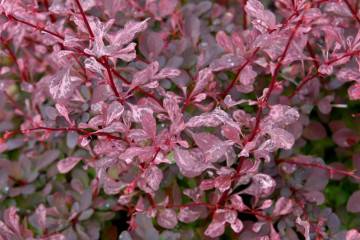Barberry Harlequin Tunberg - description, planting and care
Content:
Barberry Thunberg Harlequin is an ornamental plant variety that attracts the attention of people who have their own gardens. The color of its leaves changes depending on weather conditions, which makes the plant a truly unique natural phenomenon. That is why barberry is very popular with landscape designers.
Description of barberry
In the description of the Thunberg barberry, also called berberis Thunbergii harlequin, the following characteristics are indicated:
- plant height - 1.2-1.5 m;
- crown - lush, round, with many branches;
- shoots of a yellowish tint;
- leaves up to 3 cm in length burgundy or pink with white veins;
- spines on shoots up to 2 cm in length;
- flowering - from mid-May to early-mid June;
- berries - inedible, ripen by the end of August.
How to plant
Summer residents are attracted by the Harlequin barberry variety for a simple reason: he does not need to select special soil before planting. The best time to plant a plant is late April or early May. Some experts recommend giving preference to an autumn planting.
Any corner of the garden is suitable for growing barberry. The plant feels equally comfortable in the shade and in areas drenched in the sun. The main thing is that the landing site is not near the reservoir or in the lowland. Barberries do not like waterlogged soil.
Planting rules
An important point before planting a plant is digging up the land in the selected area, applying fertilizers of natural origin. Chicken droppings or mullein can be used as them. The process itself is carried out in several stages:
- Pits are dug for seedlings. They should not be more than 15 cm deep. It is better if they are dug at a distance of 1.5-2 m from each other.
- A drainage layer is placed at the bottom of the holes (pebbles, crushed bricks, expanded clay).
- A nutrient mixture is introduced (humus, garden soil, sand, mixed in equal parts).
- The seedling is placed in the center of the pit, covered with earth.
- The near-trunk area should be mulched with sawdust, wood chips.
- The planted plants are watered using 10 liters of water for each of them.
Plant care
It is usually indicated that the Thunberg barberry does not require special care. It is enough to follow the basic rules for the plant to please the eye.
Watering
The harlequin barberry is drought tolerant. If it rarely rains in summer, it is enough to water the plant a couple of times, using a liter of water for each seedling. Further, the soil around them is loosened and mulched. Foliage or straw is used as mulch.
Top dressing
Experts who constantly use barberry in the design of garden plots recommend feeding it periodically. As a top dressing are perfect:
- humus;
- compost;
- peat;
- fertilizer complexes of chemical origin.
During flowering, the appearance of fruits on the plant, it is also necessary to feed.
Pruning
Barberry is "cut" in several ways:
- shaping - produced in the autumn season, helps to shape the bushes;
- sanitary - recommended in spring, the goal is to eliminate dry and damaged branches;
- anti-aging - performed every seven years, the goal is to remove old shoots.
How the plant reproduces
The main methods of plant propagation are:
- planting seeds;
- cuttings;
- dividing the bush;
- planting root shoots.
The best propagation method recommended by growers is cuttings. The time for cutting side shoots for cuttings is the beginning of June. After the procedure has been performed, the cuttings are placed in a solution that stimulates root growth for a couple of hours.
Next, the plant is placed in a mixture of sand, peat, covered with glass. The substrate must be moistened and ventilated daily. After the leaves begin to appear, it is necessary to transplant the cuttings into a pot with special soil. After a year, the seedlings are sent to an open area, where they will grow constantly.
Diseases and pests
The Harlequin variety is less susceptible to diseases than other plants. However, in the absence of proper care, powdery mildew can be found in it. You can fight it with a soap-soda solution or biofungicides.
Among the pests, aphids most often attack the plant. You can get rid of it by treating the leaves with a solution of coniferous soap. Another common pest is the barberry sawfly. You can find a means of dealing with it in a florist shop.
How to prepare a plant for winter
Barberry Harlequin is able to withstand a thirty-degree frost. However, the first two years it is necessary to insulate the roots of the seedlings. Mulch can be:
- straw;
- foliage;
- coniferous needles.
The above-ground part is collected in a bundle, fixed and covered with spunbond. As soon as the frost ends in spring, it is removed.
Use in landscape design
Landscape designers often combine Harlequin with other varieties of barberry. Most often it is used to decorate:
- mixborders;
- multi-level flower beds;
- alpine slides;
- Japanese gardens.
Experts recommend using the plant to create a "hedge" or decorate borders. In this case, it is best to plant the plant in a checkerboard pattern.
Beneficial features
Harlequin barberry is edible, so many gardeners grow it on their plots. Red berries have an interesting flavor. In cooking, they are used as a seasoning, adding to main dishes. Many housewives cook compotes, jelly, fruit drinks from fruits.
The main benefit of barberry berries is to enhance immunity. They allow you not to get sick during the cold season and quickly recover if a person is nevertheless attacked by a virus. Hypertensive patients are advised to drink decoctions from berries. However, before starting treatment with folk remedies, it is important to consult a doctor.
The described variety of barberry is an ideal decoration for a summer cottage. Moreover, it can be planted around a private house where a person lives permanently. Unpretentious in care, giving useful fruits, the plant is popular with gardeners. To grow it, creating unique shapes and figures, hedges, labyrinths is a real pleasure for a person with excellent aesthetic taste.




